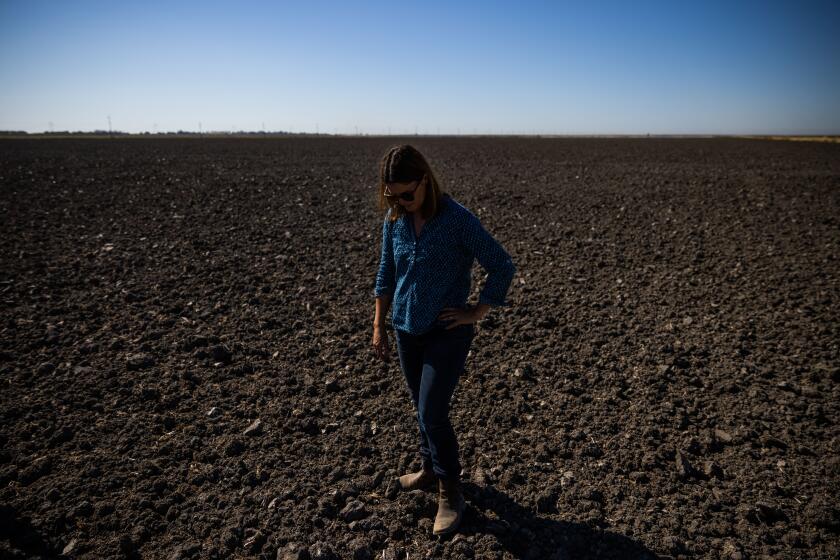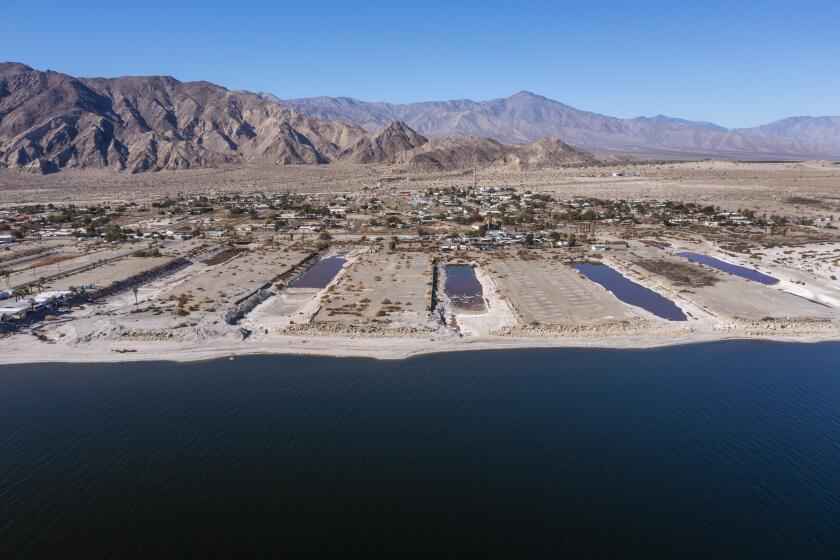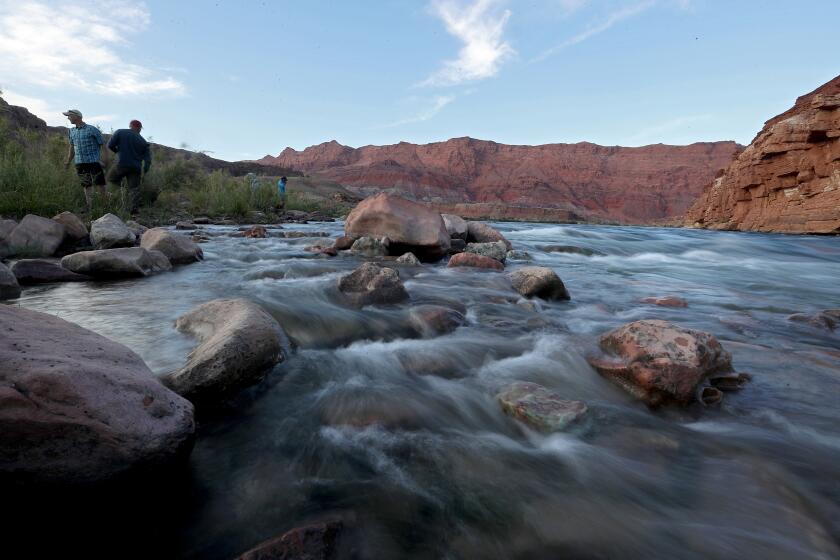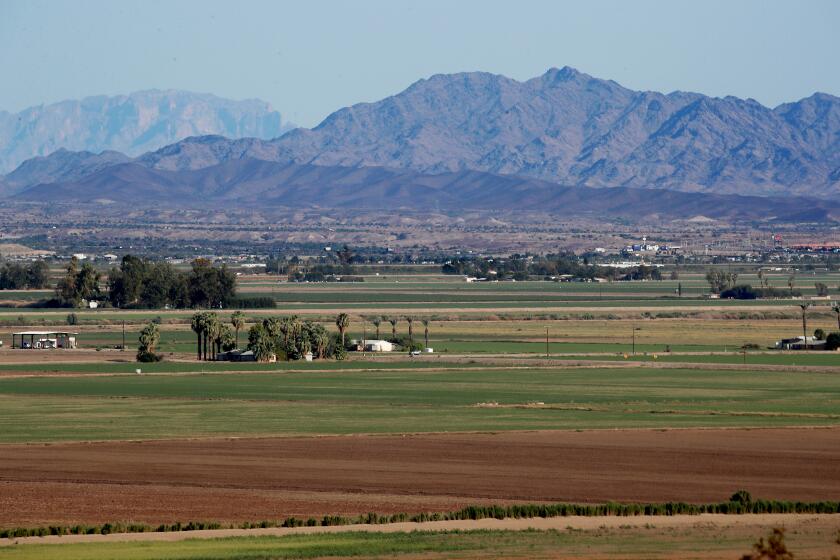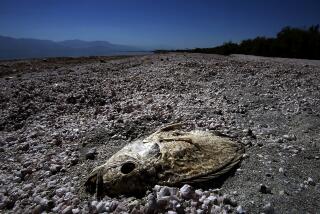U.S. government pledges $250 million to help ailing Salton Sea
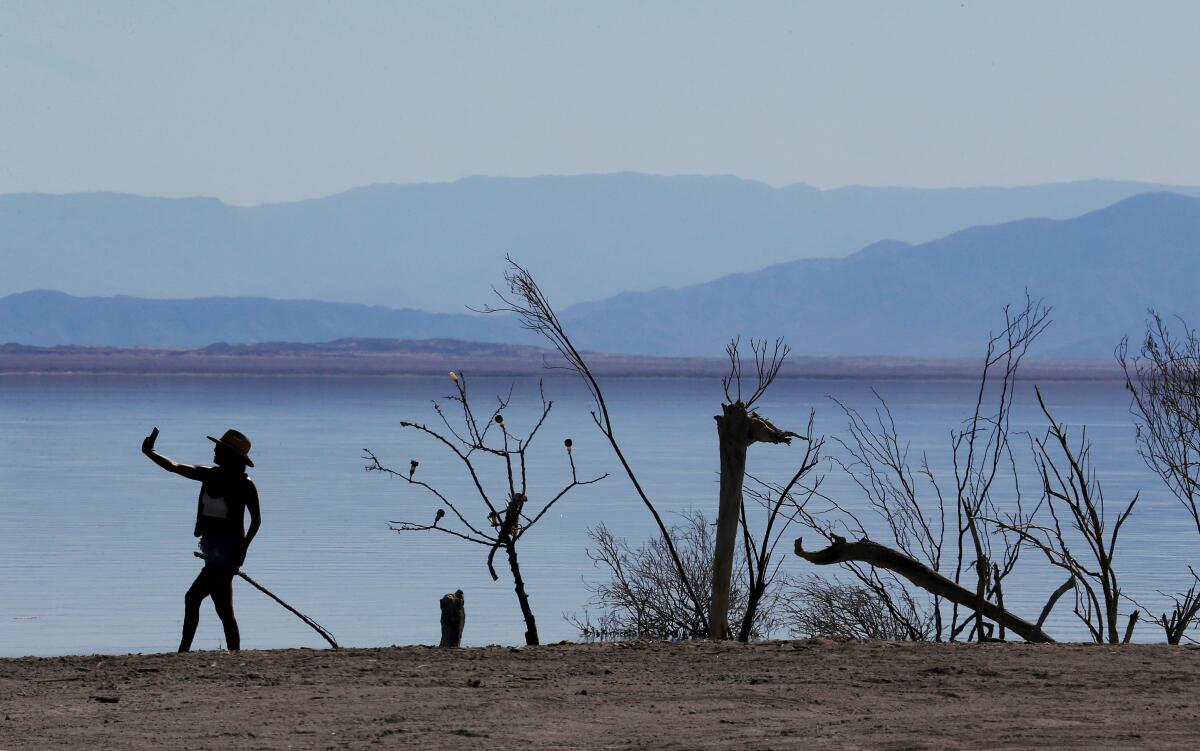
The Biden administration has announced a plan to provide $250 million to accelerate environmental projects around the shrinking Salton Sea, a major commitment intended to help revitalize the lake’s ecosystems and control hazardous dust in a deal that clears the way for California to take less water from the drought-ravaged Colorado River.
Leaders of the Imperial Irrigation District, which uses the single largest share of the Colorado River to supply farms in the Imperial Valley, had called for federal money to support the state’s Salton Sea program as a key condition for participating in water cutbacks. Some of the district’s leaders praised the funding commitment from the Interior Department and the Bureau of Reclamation, calling it a historic step toward addressing the windblown dust and deteriorating habitats that have plagued California’s largest lake.
“This checks the box big time,” said J.B. Hamby, an Imperial Irrigation District board member. “It’s a really big deal, and nothing like this has really ever happened before.”
A third year of severe drought forced California farmers to leave an estimated 752,000 acres of farmland idle this year, according to a new report.
This year, federal officials demanded large-scale water cutbacks throughout the Southwest to try to prevent the Colorado River’s reservoirs from dropping to dangerously-low levels. Four major California water districts have proposed to reduce water use by up to 400,000 acre-feet per year for the next four years, about 9% of the state’s total water allotment.
The Imperial Irrigation District has pledged to take on the largest share of California’s reductions, up to 250,000 acre-feet of water per year.
“From the outset, IID made it clear that taking action to protect the Colorado River system would have significant impacts on the Salton Sea, and that IID’s participation was conditioned on real efforts and dollars to protect public health and wildlife around the sea,” Hamby said.
He said the federal government’s new commitment “makes it much easier and simpler for us to make large contributions toward the Colorado River system.”
The infusion of federal money is the central feature of an agreement among the federal government, the Imperial Irrigation District, the California Natural Resources Agency and the Coachella Valley Water District. The Interior Department announced the plan on Monday, and the Imperial Irrigation District’s board narrowly endorsed the agreement in a 3-2 vote at a meeting Tuesday.
The debate was contentious, with some farmers, community advocates and local officials saying they didn’t think the agreement was a good deal for the Imperial Valley, or that the community should have more time to weigh in.
Luis Olmedo, executive director of the nonprofit group Comite Civico del Valle, said his organization opposed what he called a “hastily announced, half-baked deal.” He said in a statement, which a colleague read at the meeting in El Centro, that the board was deciding with little public scrutiny.
“$250 million for the Salton Sea held in front of the Imperial Valley like some carrot is insulting when we’ve been getting whacked with the stick of disrespect for decades,” Olmedo said.
Alex Cardenas, the board’s vice president, said he thinks it’s “not a good deal for our community.” He was one of two board members who voted against endorsing the deal.
Jim Hanks, the board’s outgoing president, argued that by approving the agreement, the Imperial Irrigation District is helping to secure vital funds for Salton Sea efforts and will turn next to negotiating the proposed water reductions.
“There’s not enough money in the Imperial Valley to take care of that sea,” Hanks said. “We’re just saying that sea has to be taken care of.”
He said the funding “meets the criteria for us to move to the next level.”
“This is just a first step. This is to open up negotiations for the rest of it,” Hanks said. “This is just a signal to them, ‘OK, we can move forward.’”
The Interior Department said the agreement will expedite implementation of the state’s Salton Sea Management Program, which includes creating shoreline habitat areas for birds and controlling dust along the retreating shorelines.
Deputy Interior Secretary Tommy Beaudreau said the agreement “represents a key step in our collective efforts to address the challenges the Colorado River Basin is facing due to worsening drought and climate change impacts.” He said the funds from the recently passed Inflation Reduction Act “will help to support the Imperial and Coachella Valley and the environment around the Salton Sea, as well as support California’s efforts to voluntarily save 400,000 acre-feet a year to protect critical elevations at Lake Mead.”
Some Californians want to pump desalinated ocean water to the lake to halt its decline. The state says no.
The Salton Sea covers more than 300 square miles in Imperial and Riverside counties. It sits nearly 240 feet below sea level in the Salton Trough, which over thousands of years has cycled between filling with Colorado River water and drying out.
The flooding river filled the Salton Sea from 1905 to 1907, and it has since been fed by water draining off farms in the Imperial Valley. The lake has been shrinking since the early 2000s, when the Imperial Irrigation District began selling a portion of its water to urban areas under an agreement with agencies in San Diego County and the Coachella Valley.
The strains on the Colorado River and the Salton Sea have grown during the 23-year megadrought in the Southwest, which has been intensified by higher temperatures with global warming.
Under the agreement, the federal Bureau of Reclamation will provide $22 million next year to help with projects at the lake. The agency plans to provide an additional $228 million over the next four years. It says the funds will be used to “expedite existing projects and bolster staffing capacity at the water agencies to help deliver new projects.”
That will add to the $583 million that the state has committed for the projects.
California’s 10-year plan for the Salton Sea, which came out in 2017, called for building nearly 30,000 acres of dust-control projects and wetland habitat around the lake by 2028. After years of delays, workers with heavy machinery have been moving soil at the southern end of the lake as part of a 4,110-acre project aimed at suppressing dust and creating habitat for fish and birds.
The lake’s level has declined about 11 feet since 2003. Its water is now about twice as salty as the ocean and continues to get saltier with evaporation, a shift that has caused major declines in fish and bird populations.
Along the shorelines, windblown dust contributes to harmful air pollution in low-income, predominantly Latino communities where people suffer from asthma at high rates.
California Natural Resources Secretary Wade Crowfoot called the agreement a “huge step forward.”
“It builds our momentum delivering projects at the sea to protect communities and the environment,” Crowfoot said. He said it also ensures that California’s reductions in water use don’t “come at the expense of local residents.”
California takes the largest share of water from the shrinking Colorado River. The state has agreed to reduce water use starting next year.
Several members of Congress praised the allocation of federal money for the Salton Sea, which came as part of $4 billion in the Inflation Reduction Act for drought response programs.
Sen. Alex Padilla (D-Calif.) called it “the most meaningful federal investment at the Salton Sea in history” and said it will help “more effectively address the public health and environmental disasters at the Salton Sea.”
Sen. Dianne Feinstein (D-Calif.) said the receding lake “continues to threaten the health of neighboring communities as toxic elements like arsenic and selenium are exposed and spread by strong desert winds.” She said the $250 million will help reduce the toxic dust that threatens public health and restore habit for migratory birds.
The Salton Sea has long provided a vital sanctuary for migrating birds as a stopping point on the Pacific Flyway. But in recent years, populations of many bird species have suffered declines. And some species, especially fish-eating birds, have disappeared.
“The Salton Sea presents a mushrooming crisis of human health and loss of critical habitat,” said Frank Ruiz, Audubon California’s Salton Sea program director. He said the federal funding will bring a major step forward in projects to protect residents and the environment.
“This is something that has been needed for a long time, for all the levels of government to take responsibility for the sea,” Ruiz said. He said he also thinks it’s positive that “people are finally paying attention to the sea, because this is becoming like the linchpin for the negotiations of the Colorado River water.”
Ruiz pointed out that the federal government owns a lot of land in and around the Salton Sea, and the agreement includes provisions to ensure access to build wetlands projects. The agreement also says the Interior Department will “provide administrative and technical resources to help secure any additional water supplies” needed for the habitat projects.
“My concern is that if we continue building projects on the ground, can we have the water available?” Ruiz said. “We need to make sure that there is an agreement to provide water sustainability for the projects.”
Under the agreement, the federal government also will provide money for staff jobs to help implement Salton Sea projects. That includes $2 million over five years for the Torres Martinez Desert Cahuilla Indians to hire at least two people to help with wetlands projects on tribal lands by the sea, as well as $2 million for the Imperial Irrigation District and $1 million for the Coachella Valley Water District to hire additional staff to help accelerate the efforts.
As Colorado River levels continue to drop, water agencies are working with local growers to leave some fields fallow in exchange for cash payments.
“The collaboration happening at the Salton Sea between water agencies and state, federal and tribal governments is a blueprint for effective cooperation that the Colorado River Basin sorely needs,” Hamby said.
To address the shortage and reduce risks of reservoirs dropping to critically low levels, Bureau of Reclamation Commissioner Camille Calimlim Touton announced in June that water cutbacks of 2 million to 4 million acre-feet will be needed across the region in 2023, a decrease of roughly 15% to 30%. Negotiations among the seven states that rely on the river have grown tense and have failed to produce a deal for such large reductions.
Hamby said he and others at the Imperial Irrigation District appreciate Touton’s efforts to prioritize funding for the Salton Sea.
“Historically, there has been some level of federal presence on the sea. But this adds an entirely new dimension to it, with the funding, with the level of cooperation,” Hamby said.
The stepped-up federal involvement on the Salton Sea’s issues, he said, will help the Imperial Irrigation District move ahead with its proposal for reducing water use to help protect reservoir levels.
The Imperial Irrigation District’s leaders have pledged to reduce water use by up to 250,000 acre-feet a year for the next four years, a cut of more than 9%. Farmers and irrigation district officials have said they plan to prioritize saving water by improving efficiency, both on farms and in the canal system that delivers water, rather than leaving fields dry.
However, Hamby said that some amount of land-fallowing will probably be necessary “at least for a temporary, short period of time,” to achieve the reductions.
Farmers in the Imperial Valley, who produce crops such as alfalfa, lettuce and broccoli, have told the federal government they hope to avoid fallowing farmland. In a letter to Touton this month, leaders of the Imperial County Farm Bureau said the government’s plan to pay between $330 and $400 per acre-foot of conserved water “will not be adequate to secure meaningful agreements.”
“In the Imperial Valley, water conservation should be accomplished through improved efficiency as opposed to fallowing,” the farmers wrote.
Some representatives of other states are pushing for California, which uses the largest share of the river, to make larger reductions.
Sen. Mark Kelly (D-Ariz.) had urged the federal government to withhold funding for the Salton Sea “until California commits additional water.”
For the record:
5:31 p.m. Nov. 29, 2022An earlier version of this article misspelled Sen. Mark Kelly’s last name as Kelley.
Now that the government has come forward with the money, Kelly said he is still looking to California to shoulder larger cuts.
“As the largest water user on the Colorado River, California must step up and do more to conserve water alongside other states to protect the Colorado River system that millions of Americans rely on,” Kelly said in an email.
